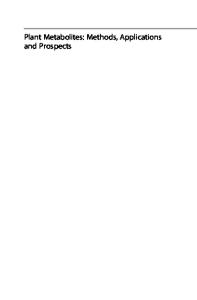Virulent secondary metabolites of entomopathogenic bacteria genera, Xenorhabdus and Photorhabdus , inhibit phospholipase
- PDF / 1,821,462 Bytes
- 13 Pages / 595.276 x 790.866 pts Page_size
- 76 Downloads / 285 Views
RESEARCH ARTICLE
Open Access
Virulent secondary metabolites of entomopathogenic bacteria genera, Xenorhabdus and Photorhabdus, inhibit phospholipase A2 to suppress host insect immunity Md. Mahi Imam Mollah and Yonggyun Kim*
Abstract Background: Xenorhabdus and Photorhabdus are entomopathogenic bacteria that cause septicemia and toxemia in insects. They produce secondary metabolites to induce host immunosuppression. Their metabolite compositions vary among bacterial species. Little is known about the relationship between metabolite compositions and the bacterial pathogenicity. The objective of this study was to compare pathogenicity and production of secondary metabolites of 14 bacterial isolates (species or strains) of Xenorhabdus and Photorhabdus. Results: All bacterial isolates exhibited insecticidal activities after hemocoelic injection to Spodoptera exigua (a lepidopteran insect) larvae, with median lethal doses ranging from 168.8 to 641.3 CFU per larva. Bacterial infection also led to immunosuppression by inhibiting eicosanoid biosynthesis. Bacterial culture broth was fractionated into four different organic extracts. All four organic extracts of each bacterial species exhibited insecticidal activities and resulted in immunosuppression. These organic extracts were subjected to GC-MS analysis which predicted 182 compounds, showing differential compositions for 14 bacteria isolates. There were positive correlations between total number of secondary metabolites produced by each bacterial culture broth and its bacterial pathogenicity based on immunosuppression and insecticidal activity. From these correlation results, 70 virulent compounds were selected from secondary metabolites of high virulent bacterial isolates by deducting those of low virulent bacterial isolates. These selected virulent compounds exhibited significant immunosuppressive activities by inhibiting eicosanoid biosynthesis. They also exhibited relatively high insecticidal activities. Conclusion: Virulence variation between Xenorhabdus and Photorhabdus is determined by their different compositions of secondary metabolites, of which PLA2 inhibitors play a crucial role. Keywords: Xenorhabdus, Photorhabdus, Secondary metabolite, Pathogenicity, Eicosanoid, Immunity
* Correspondence: [email protected] Department of Plant Medicals, College of Life Sciences, Andong National University, Andong 36729, South Korea © The Author(s). 2020 Open Access This article is licensed under a Creative Commons Attribution 4.0 International License, which permits use, sharing, adaptation, distribution and reproduction in any medium or format, as long as you give appropriate credit to the original author(s) and the source, provide a link to the Creative Commons licence, and indicate if changes were made. The images or other third party material in this article are included in the article's Creative Commons licence, unless indicated otherwise in a credit line to the material. If material is not included in the article's Creative Commons licence and your intended use is n
Data Loading...











